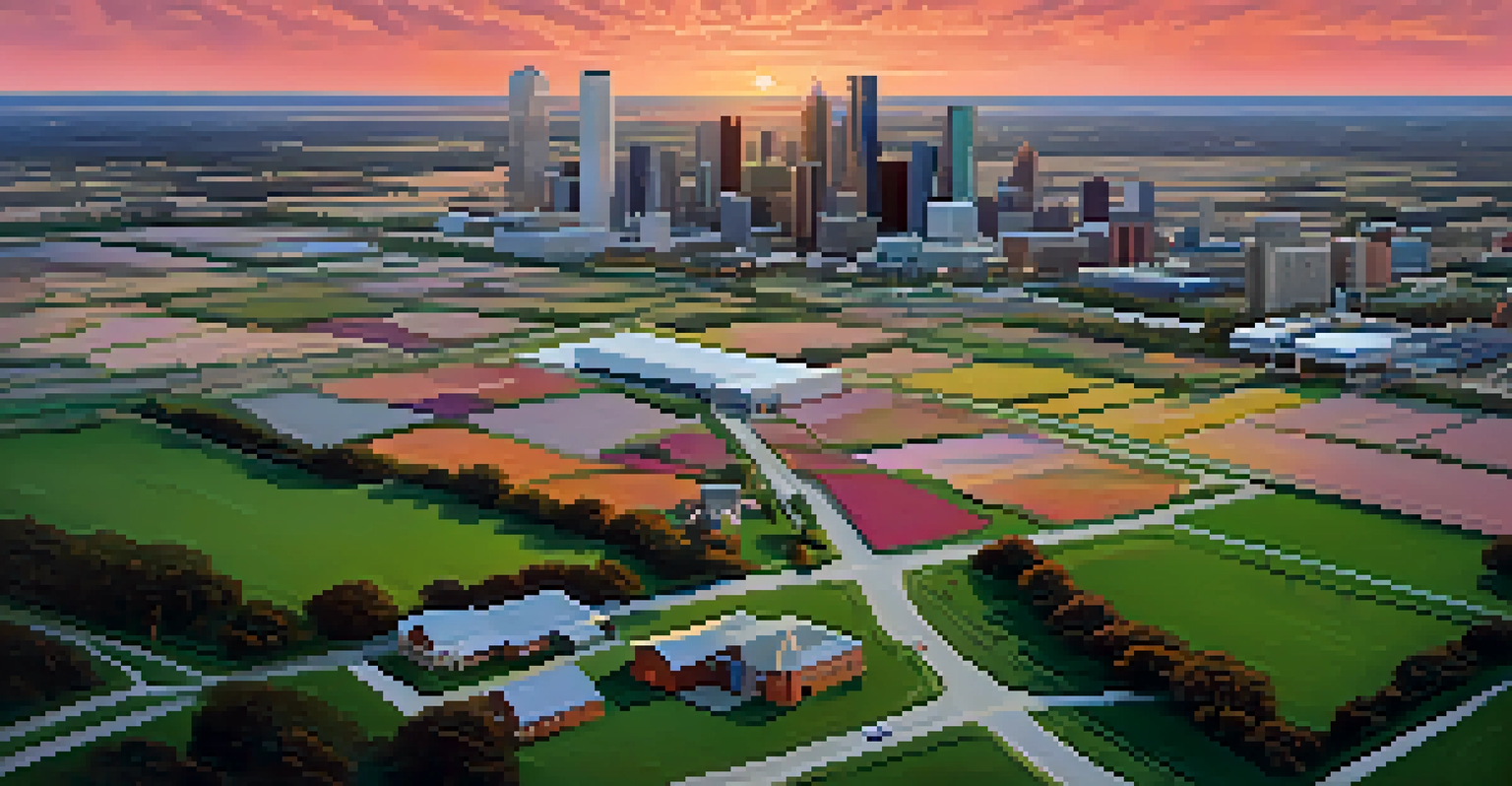Texas Political Landscape: Trends and Future Outlook

Historical Context of Texas Politics: A Brief Overview
Texas has a rich political history shaped by its unique cultural identity and diverse population. From its days as an independent republic to becoming a cornerstone of the Republican Party, the state's political landscape has evolved significantly. Key events, such as the Civil War and the Civil Rights Movement, have left lasting impacts on its political affiliations and voter sentiments.
In Texas, politics are driven by demographics and the evolving needs of its diverse population.
Understanding this historical backdrop is crucial as it sets the stage for current trends. For instance, the legacy of the Democratic Party in Texas, particularly during the mid-20th century, contrasts sharply with the state's current Republican dominance. This historical context helps explain why certain regions lean more conservative or liberal today.
Moreover, the state's rapid population growth, particularly among younger and more diverse voters, is reshaping Texas politics. This demographic shift signals that while Texas has a storied history, the future may hold new political dynamics as emerging voices demand representation.
Key Demographic Shifts Influencing Political Change
Demographics play a pivotal role in shaping the political landscape of Texas. The state has seen a significant influx of Hispanic and Asian populations, which are increasingly becoming vital voting blocs. As these communities gain political awareness and representation, their influence on elections is likely to grow, challenging traditional voting patterns.

Additionally, the urban-rural divide in Texas is becoming more pronounced. Cities like Austin, Houston, and Dallas are trending Democratic, while many rural areas remain staunchly Republican. This urbanization trend not only alters the political landscape but also highlights the differing priorities and perspectives across the state.
Demographics Reshaping Texas Politics
The influx of diverse populations, particularly Hispanic and Asian communities, is significantly influencing voting patterns and political representation in Texas.
As we've seen in recent elections, the potential for swing districts is increasing, leading to a more competitive political environment. Campaigns are now focusing more on issues that resonate with these diverse demographics, creating a platform for future leaders who can bridge these divides.
Major Political Parties: Current Strengths and Weaknesses
The Republican Party has enjoyed a stronghold in Texas politics for decades, often winning statewide offices and dominating congressional seats. However, recent elections have shown cracks in this dominance, with Democrats making significant gains in urban areas and key districts. This shift indicates a potential realignment in party strength as more Texans engage in the political process.
The future of Texas politics will hinge on the ability of leaders to listen to their constituents and respond to their needs.
On the other hand, the Democratic Party, while traditionally marginalized in Texas, has been investing in grassroots organizing and outreach. Their efforts to mobilize younger voters and communities of color are beginning to show results, signaling a more competitive landscape in future elections. The challenge remains for the party to maintain momentum and unify its base.
Both parties must adapt to the changing political climate, especially with the rise of independent voters who are increasingly disillusioned with traditional party politics. The quest for relevance in this evolving landscape will define the strategies of both parties moving forward.
Impact of National Politics on Texas' Local Landscape
The political climate in Texas is undeniably influenced by national trends and events. For instance, the polarization seen in Washington has trickled down to state politics, with local candidates often aligning themselves with national party narratives. This alignment can energize voter bases but also alienate moderates seeking compromise.
Recent events, such as the COVID-19 pandemic and social justice movements, have further galvanized political engagement in Texas. The state's handling of these issues has become a focal point for both parties, with candidates leveraging local responses to national narratives to rally support. This creates a dynamic interplay between local concerns and national agendas.
National Trends Affect Local Politics
National political polarization and events, such as the COVID-19 pandemic, are shaping the local Texas political landscape and candidate strategies.
As Texas continues to play a crucial role in national elections, its local political landscape will remain a microcosm of broader trends. Understanding this relationship is key for voters and candidates alike as they navigate the complexities of modern politics.
Emerging Issues Shaping Texas Political Discourse
Several pressing issues are at the forefront of Texas political discourse today, including immigration, healthcare, and education. These topics resonate deeply with voters and often dictate campaign strategies. Candidates are increasingly challenged to provide clear, actionable solutions to these complex problems that affect everyday Texans.
Additionally, climate change and energy policy have gained prominence, particularly in light of Texas' vulnerability to extreme weather events. As more Texans advocate for sustainable practices, the political conversation is evolving to include alternative energy sources and environmental protections. This shift indicates a growing awareness of interconnected global challenges.
The debate over gun control remains another contentious issue, reflecting the state's historical ties to gun rights. Candidates must navigate these discussions carefully, balancing the desires of constituents while addressing safety concerns. How these issues are handled will likely play a significant role in shaping future electoral outcomes.
The Role of Technology in Texas Politics
Technology has transformed the political landscape in Texas, particularly in terms of campaign strategies and voter engagement. Social media platforms have become essential tools for candidates to connect with constituents, share their messages, and mobilize supporters. This shift has democratized information dissemination, allowing for more voices to be heard.
Moreover, technology is playing a crucial role in voter registration and turnout efforts. Organizations are leveraging data analytics to identify and reach potential voters, making it easier for individuals to participate in the electoral process. This increased accessibility could enhance civic engagement, especially among younger demographics.
Technology's Role in Political Engagement
Advancements in technology, especially social media and data analytics, are transforming how candidates engage voters and run campaigns in Texas.
However, with these advancements come challenges, such as misinformation and data privacy concerns. Candidates and parties must navigate these issues carefully to maintain trust and credibility with voters. As technology continues to evolve, its impact on Texas politics will undoubtedly shape the future of electoral campaigns.
Future Outlook: What Lies Ahead for Texas Politics
Looking ahead, the Texas political landscape is poised for significant transformation. With demographic shifts and evolving voter priorities, both parties must adapt to remain relevant. As younger generations become more politically active, their values and concerns will shape the future of Texas politics.
Moreover, the competitive nature of upcoming elections suggests that Texas may become a battleground state. This shift could lead to increased investment from both parties and greater attention to local issues that matter to constituents. Candidates will need to engage meaningfully with voters to earn their trust and support.

Ultimately, the future of Texas politics will hinge on the ability of leaders to listen to their constituents and respond to their needs. As the state continues to grow and diversify, the political landscape will reflect these changes, promising an exciting journey ahead for Texas.